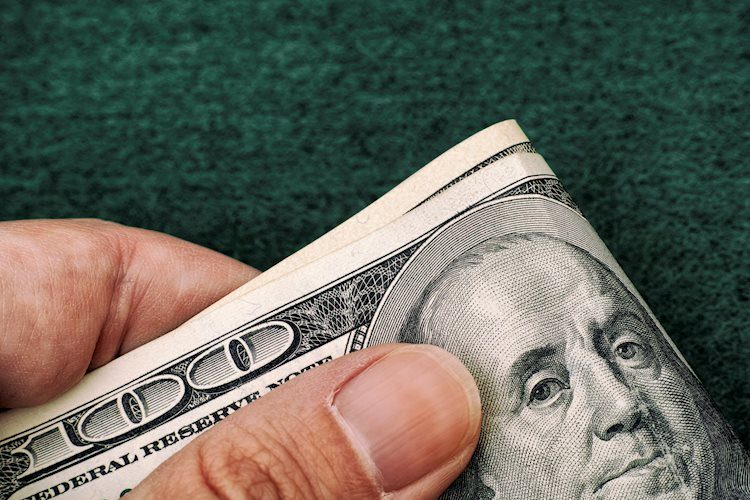
- US Dollar stays strong against its major rivals to start the week.
- US Dollar Index clings to modest daily gains above 101.00.
- US data showed that private sector’s economic activity continued to expand in July.
The US Dollar started the new week on a bullish note after having outperformed its major rivals in the previous week. The US Dollar Index, which tracks the USD’s valuation against a basket of six major currencies, touched its highest level since July 12 near 101.50 in the early European session.
The USD captured capital outflows out of the Euro and Pound Sterling after the Services and Manufacturing PMI data from Germany, the EU and the UK came in weaker than expected for early July.
US S&P Global Manufacturing PMI improved to 49 in July’s flash estimate from 46.3 in June. Services PMI edged lower to 52.4 from 54.4 in the same period. Finally, Composite PMI declined to 52 from 53.2, pointing to an ongoing expansion in the private sector’s business activity, albeit at a softening pace.
The US Federal Reserve’s two-day policy meeting will start on Tuesday and the interest rate decision will be announced on Wednesday.
Daily digest market movers: US Dollar gathers strength to start Fed week
- Commenting on PMI surveys’ findings, “July is seeing an unwelcome combination of slower economic growth, weaker job creation, gloomier business confidence and sticky inflation,” said Chris Williamson, Chief Business Economist at S&P Global Market Intelligence. “The overall rate of output growth, measured across manufacturing and services, is consistent with GDP expanding at an annualized quarterly rate of approximately 1.5% at the start of the third quarter,” he added.
- 10-year US Treasury bond yield staged a rebound in the second half of last week and closed above 3.8% after having declined toward 3.7% earlier in the week. Following the PMI data, 10-year yield holds steady at around 3.8%.
- According to the CME Group FedWatch Tool, a 25-basis-point Fed rate hike on Wednesday is fully priced in. The probability of the Fed hiking the policy rate one more time before the end of the year stands at 23%.
- Assessing the USD’s short-term outlook, “positioning data suggests investors are running reasonably large short Dollar positions into this week’s Fed, ECB and BoJ policy meetings,” noted economists at ING. “We do like a weaker USD later this year, but the Dollar’s recent corrective rally might endure this week if the Fed hangs onto its tightening bias.”
- Wall Street’s main indexes opened mixed on Monday. After the opening bell, the Dow Jones Industrial Average was up 0.4% and the Nasdaq Composite was down 0.2%.
- German HOCB Composite PMI fell to 48.3 in Early July from 50.6 in June. Commenting on the data, “There is an increased probability that the economy will be in recession in the second half of the year,” said Dr. Cyrus de la Rubia, Chief Economist at Hamburg Commercial Bank (HCOB).
- HCOB Composite PMI for the Eurozone worsened to 48.9 from 49.9 in the same period, while the UK S&P Global/CIPS Composite PMI fell to 50.7 from 52.8.
Technical analysis: US Dollar Index looks to continue to push higher
The US Dollar Index (DXY) started to edge higher after having tested 101.00 (static level) earlier in the day, confirming that level as important near-term support. Meanwhile, the Relative Strength Index (RSI) indicator on the daily chart extended its recovery toward 50, reflecting the lack of seller interest.
On the upside, the 20-day Simple Moving Average (SMA) aligns as dynamic resistance at 101.70 ahead of 102.00 (static level, former support). A daily close above the latter could bring in additional buyers and open the door for an extended uptrend toward 102.50/60 (50-day SMA, 100-day SMA).
In case the DXY returns below 101.00, 100.50 (static level) could be seen as the next support before 100.00 (psychological level, static level).
Fed FAQs
Monetary policy in the US is shaped by the Federal Reserve (Fed). The Fed has two mandates: to achieve price stability and foster full employment. Its primary tool to achieve these goals is by adjusting interest rates.
When prices are rising too quickly and inflation is above the Fed’s 2% target, it raises interest rates, increasing borrowing costs throughout the economy. This results in a stronger US Dollar (USD) as it makes the US a more attractive place for international investors to park their money.
When inflation falls below 2% or the Unemployment Rate is too high, the Fed may lower interest rates to encourage borrowing, which weighs on the Greenback.
The Federal Reserve (Fed) holds eight policy meetings a year, where the Federal Open Market Committee (FOMC) assesses economic conditions and makes monetary policy decisions.
The FOMC is attended by twelve Fed officials – the seven members of the Board of Governors, the president of the Federal Reserve Bank of New York, and four of the remaining eleven regional Reserve Bank presidents, who serve one-year terms on a rotating basis.
In extreme situations, the Federal Reserve may resort to a policy named Quantitative Easing (QE). QE is the process by which the Fed substantially increases the flow of credit in a stuck financial system.
It is a non-standard policy measure used during crises or when inflation is extremely low. It was the Fed’s weapon of choice during the Great Financial Crisis in 2008. It involves the Fed printing more Dollars and using them to buy high grade bonds from financial institutions. QE usually weakens the US Dollar.
Quantitative tightening (QT) is the reverse process of QE, whereby the Federal Reserve stops buying bonds from financial institutions and does not reinvest the principal from the bonds it holds maturing, to purchase new bonds. It is usually positive for the value of the US Dollar.